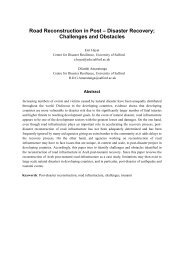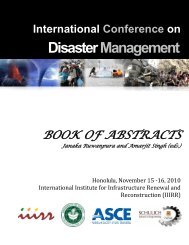Spatial Pattern of Socio-economic Landslide Vulnerability and its ...
Spatial Pattern of Socio-economic Landslide Vulnerability and its ...
Spatial Pattern of Socio-economic Landslide Vulnerability and its ...
Create successful ePaper yourself
Turn your PDF publications into a flip-book with our unique Google optimized e-Paper software.
tool <strong>and</strong> trending topic in order to figure out place-based vulnerability analysis. However, there are several<br />
major considerations should be underlined in the development <strong>of</strong> spatial vulnerability analysis. Scale<br />
analysis <strong>and</strong> the robustness <strong>of</strong> method are important aspect to employ GIS technique in vulnerability<br />
assessment.<br />
The scale analysis <strong>of</strong> vulnerability assessment is usually driven by the availability <strong>of</strong> data <strong>and</strong> usually<br />
applied in site specific location or over to the large area. It was usually based on the analysis <strong>of</strong> secondary<br />
traditional vulnerability data based on administrative unit i.e. age, gender, literacy, <strong>and</strong> population. The main<br />
drawback <strong>of</strong> this procedure is the unmatched <strong>of</strong> administrative data <strong>and</strong> the boundary <strong>of</strong> study area. For<br />
instance, the problem arises when dem<strong>and</strong>ed on the analysis <strong>of</strong> catchment area in which the boundaries <strong>of</strong><br />
catchment is oversize or undersize with the administrative unit. Due to lack <strong>of</strong> data on the household<br />
characteristic, the vulnerability per settlement area is also difficult to be estimated by administrative based<br />
data. The choice in the scale analysis <strong>of</strong> observation <strong>and</strong> <strong>its</strong> spatial unit is necessary in spatial vulnerability<br />
assessment (Fekete, 2010).<br />
To overcome the limitation <strong>of</strong> administrative data, the socio-<strong>economic</strong> vulnerability data should be<br />
collected by direct survey (primary data). Those are only available obtained through census or <strong>and</strong><br />
community based methods. However, data collected using house-to-house surveys <strong>and</strong> community based<br />
methods have limited efficiency <strong>and</strong> transferability (Ebert et al., 2009). Medium scale vulnerability<br />
assessment based on catchment analysis focused on household level is challenging in order to breakdown the<br />
drawbacks <strong>of</strong> traditional spatial vulnerability assessment. It will be very valuable to explain the spatial<br />
interdependencies <strong>of</strong> l<strong>and</strong>slide phenomenon in the framework <strong>of</strong> environmental system. Sampling technique<br />
was proposed in order to overcome timely <strong>and</strong> costly census procedure. However, the limitation <strong>of</strong> the<br />
sampling technique is related to the generalization <strong>of</strong> spatial unit attribute. Limited sample will only describe<br />
a small portion <strong>of</strong> whole spatial unit attribute in the entire the study area. Generalization <strong>of</strong> the sample data<br />
should fulfill the requirement <strong>of</strong> vulnerability information in each spatial unit in the whole study area. It<br />
requires an underst<strong>and</strong>ing <strong>of</strong> relationship between vulnerability information <strong>and</strong> the environment factors<br />
affecting them. <strong>Spatial</strong> data analysis focusing on detecting pattern is a capable tool to underst<strong>and</strong> processes<br />
which are responsible for observed patterns (Fischer, 2002).<br />
<strong>Spatial</strong> pattern analysis focuses on the describing space as an important role to derive socio-<strong>economic</strong><br />
process in the space-time context. It is powerful analysis to recognize phenomenon related to the spatial<br />
interaction among observed field. Household sample is derived to draw inferences about underlying process<br />
<strong>of</strong> socio-<strong>economic</strong> vulnerability <strong>and</strong> <strong>its</strong> environment based on the settlement block spatial unit. Average<br />
nearest neighbor analysis was employed in order to figure out the spatial pattern <strong>of</strong> socio-<strong>economic</strong> l<strong>and</strong>slide<br />
vulnerability. Geographic distribution <strong>of</strong> mean centre analysis, st<strong>and</strong>ard distance <strong>and</strong> directional distribution<br />
were also employed in order to identify spatial tendency <strong>and</strong> spatial distribution <strong>of</strong> socio-<strong>economic</strong><br />
vulnerability. It was intended to explore the interdependencies between socio-<strong>economic</strong> l<strong>and</strong>slide<br />
vulnerability with <strong>its</strong> environmental factor. Then, the spatial pattern analysis was applied as an input <strong>of</strong> fuzzy<br />
membership technique to predict socio-<strong>economic</strong> l<strong>and</strong>slide vulnerability in the whole settlement block <strong>of</strong><br />
Kayangan Catchment. Therefore, the objective <strong>of</strong> this paper is to propose medium scale spatial vulnerability<br />
analysis based on the socio-<strong>economic</strong> indicators through fuzzy logic technique.<br />
2. STUDY AREA<br />
The research area was conducted in Kayangan Catchment Kulon Progo, Yogakarta Indonesia (Figure 1).<br />
The area <strong>of</strong> Kayangan Catchment extends 4 sub-districts i.e. Girimulyo, Nanggulan, Samigaluh <strong>and</strong><br />
Kaligesing. It is located in the middle Java Isl<strong>and</strong> <strong>and</strong> comprises 35 km 2 . The average annual rainfall in<br />
Kayangan Catchment is 2478 mm. The highest rainfall intensity usually occurs from February to March with<br />
average monthly rainfall 426 mm. <strong>L<strong>and</strong>slide</strong> usually occurs in the month <strong>of</strong> November to April during wet<br />
season. L<strong>and</strong> use in the study area can be classified into bushes, rain fed paddy field, irrigated paddy field,<br />
people forest, settlement, <strong>and</strong> dry cultivated l<strong>and</strong>.<br />
Kulon Progo area has been traditionally dominated by agricultural sector. It is also the second lowest<br />
<strong>economic</strong> growth <strong>and</strong> the welfare level has only 8.7% <strong>of</strong> total GDP among 5 regencies in Yogyakarta<br />
Province. Around 78% household working in agricultural sector <strong>and</strong> mostly (88%) are living in rural areas.<br />
With the limitation <strong>of</strong> <strong>economic</strong> development <strong>and</strong> infrastructure, 40.31 % people are living below national<br />
poverty line (BPS, 2008). Due to inadequate access <strong>and</strong> resource to <strong>economic</strong> development, it may increase<br />
socio-<strong>economic</strong> vulnerability level when disaster occurs.<br />
2<br />
- 521 -
















